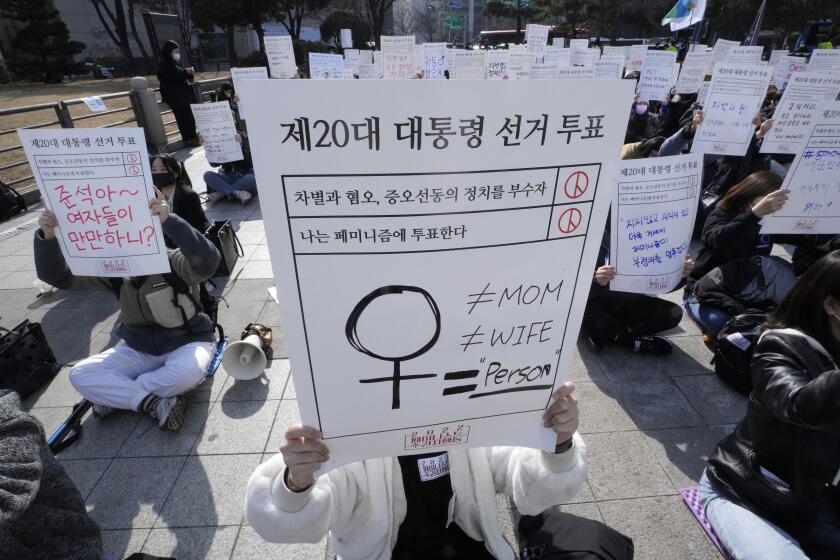Trump Hits a Neighborhood Roadblock
- Share via
NEW YORK — Whether flying over Manhattan in his helicopter or grilling would-be tycoons on his television hit, “The Apprentice,” Donald Trump gives the appearance of a man above the fray.
Yet the city’s plan to shut down an offramp on Manhattan’s West Side Highway to accommodate his latest real estate venture has set the stage for a bruising battle between civic activists and the man whose name is on some of New York’s most glittering properties.
Neighborhood leaders fear that any permanent ramp closure on the highway -- which borders a populated community -- will generate massive traffic congestion. And they vow their campaign against Trump Place, a $3-billion commercial and residential project, will get messy.
“We hit them hard with lawsuits and we build from there,” said Madeleine Polayes, president of the Coalition for a Livable West Side. “We have got to organize against this shutdown. We’re not going to let him steamroll us.”
Trump and his organization did not return a call asking for comment.
To some, the notion that New York would close down a crucial offramp to help out a prominent developer smacks of favoritism.
Critics say the project on the Upper West Side -- which calls for 5,700 apartment units, 137,800 square feet of commercial space and 17 new buildings -- will create gridlock on local streets and on the West Side Highway, with traffic patterns changing as motorists are forced to use other exits.
The elected officials representing the neighborhood, long known for its activism, all oppose the shutdown.
Trump is “getting an extraordinary gift that others don’t get,” Assemblyman Scott Stringer said. “All we’re saying is: What’s the big rush? Why do we have to close the offramp now, before we can look into something less drastic?”
Yet the city has a history of approving swaths of land for highways and housing. And backers of Trump Place suggest the proposed shutdown of the West 72nd Street exit is a small price to pay for a development they say will bring new life to the area.
Others are looking to find some middle ground.
“I would hope that we could settle this issue about the offramp calmly, without it getting into a pro-Trump and anti-Trump battle,” said Andrew Albert, a planning official with Community Board 7, which represents the neighborhood. “But given what we’ve seen already from both sides, I’m not too hopeful that will happen.”
The project on Manhattan’s largest undeveloped plot of land, just off the West Side Highway near the Hudson River, has been a work in progress since Trump won approval in 1992.
Although the controversy has been simmering for years, it heated up last month when city officials -- with little warning -- announced they had approved the ramp shutdown.
To alleviate traffic and make room for even more motorists, Trump previously agreed to build a new avenue, called Riverside Boulevard, that would begin at the project’s southern 59th Street boundary and link up with the existing Riverside Drive at 72nd Street running north. But in order to do that, project backers said, a northbound offramp would have to be eliminated.
Trump has said that the closure was essentially agreed to 14 years ago when he, city officials and local nonprofit groups reached a compromise -- which also called for a park and recreational pier -- allowing him to build along the dilapidated, little-used waterfront.
Several buildings already have gone up. And when Trump approached officials last year asking that construction be expedited, said Tom Cocola, spokesman for the Department of Transportation, New York’s main task was to ensure that current environmental problems -- such as traffic -- were not noticeably differently than those identified in 1992.
“We basically said there wasn’t a big difference” between environmental conditions then and now, Cocola said. But he added that the city would not close the ramp until key improvements were made to local streets. Those include adding two new lanes on nearby West End Avenue to handle increased levels of traffic congestion.
Polayes and other critics contend that the 1992 agreement did not call for closure of the offramp. In fact, they note, an environmental impact statement suggested that if the offramp could not be closed without some damage resulting, then the project should be changed.
Activists representing about 65 neighborhood organizations are lining up to support litigation against the city’s decision. And that’s just the beginning, said Miriam Febus, who heads the West Side Federation of Neighborhood and Block Assns.
“I wouldn’t rule out demonstrations or anything,” she said. “The lawsuit is not the only means we have to fight back. [Trump] hasn’t really seen us when we get angry.”
More to Read
Sign up for Essential California
The most important California stories and recommendations in your inbox every morning.
You may occasionally receive promotional content from the Los Angeles Times.













